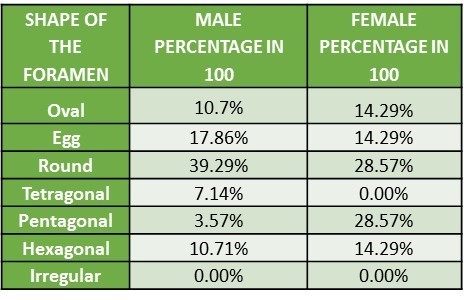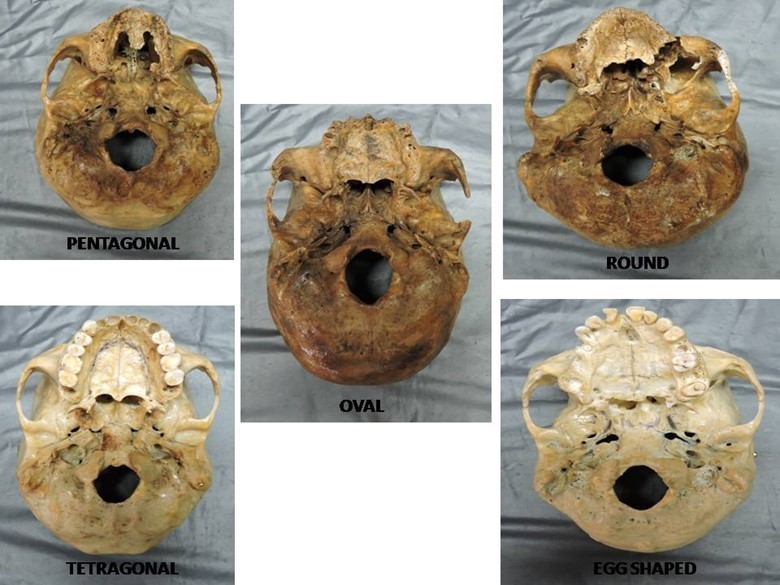International Journal of Anatomical Sciences 2014, 5(2): 43-45
Research Article
Morphometric Study of the Foramen Magnum in Adult Human Skulls in South Indian Population
Sumana R, Kirubhanand C, Shradha Iddalgave
Department of Anatomy, Karuna Medical College, Vilayodi, Palakkad- 678 103, Kerala, India.
Key words: foramen magnum, morphology, morphometry, skull
Abstract: The morphometric evaluation of foramen magnum is interesting due to its relation with its contents. The aim of the present study was to conduct a morphometric analysis of foramen magnum. Completely ossified 100 adult human dry skulls of unknown age and sex were taken primarily from the Department of Anatomy of Karuna Medical College, Vilayodi, Palakkad were used for the study.
Foramen magnum is a Latin word meaning largest aperture in the skull. Foramen magnum is the most conspicuous feature of the cranial base. The four parts of occipital bones are forming its boundaries. The major structures passing through this large foramen are medulla oblongata with the meninges, vertebral arteries, anterior and posterior spinal arteries and accessory nerves. Foramen magnum can be used for sex determination of the individuals. Hence in the present study, morphometric and morphological analysis of foramen magnum and its variations in the shape in human skull bones was taken.Many authors have classified foramen magnum depending upon its shapes, such as oval, egg shaped, and round, tetragonal, pentagonal, hexagonal and irregular
Materials and Methods
The skull samples which were deformed were excluded from the study. All the 100 cranial bases were visually assessed for foramen magnum shape classification. Each foramen magnum was classified into one of the four shapes, oval, round, irregular, tetragonal, pentagonal and hexagonal. The antero-posterior and transverse diameters were measured using a vernier caliper graded upto 0.01mm. Observations made were tabulated and photographed.
Observations
In the present study oval shaped foramen magnum were found more frequently in female. In the study done, the Round shaped foramen magnums were more frequent in both sexes (Table 1 & Fig. 1).

Table 1 Incidences of various shapes of foramen magnum
Fig 1 Histogram showing incidences of various shapes of foramen magnum in both the sexes.
Tetragonal shaped foramen magnum were found only in male. Whereas pentagonal shaped foramen magnum were predominant in females then male. Hexagonal shaped foramen magnum almost equaled the number in both sexes. We did not come across any irregular foramen magnum (Fig 2).

Discussion
The foramen magnum reaches its adult size rather early in childhood and is therefore unlikely to respond to significant secondary sexual changes (Santhosh CS, Vishwanathan KG, Ashok Gupta, Siddesh RC, 2013). From a mechanical point of view, no muscles act upon the shape and size of the foramen magnum and its prime function is to accommodate the passage of structures into and out of the cranial base region and in particular, medulla oblongata which occupies the greatest portion of the foramen space.

Fig 2 Photograph showing various shapes of foramen magnum observed in the study
Population differences are also important in defining sexual differences in the cranium. Therefore sexual differences in the foramen magnum Therefore, it is necessary to know the source population of any unidentified skull and adopt a method based data from that population or a population with similar expression of sexual dimorphism. The LFM and WFM in the South Indian population is a useful indicator of sex, and comparison to values from other populations demonstrates similar results among some of the populations.
The shape and morphological variations of foramen magnum are important in neurological interpretation (Radhika et al., 2014). In an ovoid type of the foramen magnum, the surgeon may find it difficult to explore the anterior portion of the foramen magnum. The morphometric analysis of foramen magnum and its variations is important not only anatomists but also to the anesthetist, neurosurgeons, orthopedicians, radiologists.
The sex determination of incomplete or damaged skeletons is an important task in forensic medicine (Santhosh et al., 2013). Anthropometric measurements can aid in solving such problems of gender identification. The foramen magnum was used since it is a regular structure and less likely to major morphological changes.
Conclusion
Hence, it can be concluded that careful radiological analysis of foramen magnum is required before craniovertebral junction surgery to prevent inadvertent complications such as hemorrhage, atlanto occipital instability and injury to major structures passing through foramen magnum. The sexual dimorphism of foramen magnum dimensions is established in the study. However, due to considerable overlapping of male and female values, it is unwise to singularly rely on the foramen measurements. However, considering the high sex predictability percentage of their dimensions in the present study and the studies preceding it, the foramen measurements can be used to supplement other sexing evidence available so as to precisely ascertain the sex of the skeleton.
References
Radhika PM, Shailaja S, Prathap KJ, Sheshgiri C (2014) Morphometric Study of The Foramen Magnum In Adult Human Skulls In Indian Population.Asian J Med Clin Sci, 3:68–72.
Santhosh CS, Vishwanathan KG, Ashok Gupta, Siddesh RC and TJ (2013) Morphometry of the Foramen Magnum: An Important Tool in Sex Determination.Res Rev J Med Heal Sci , 2:88–91
